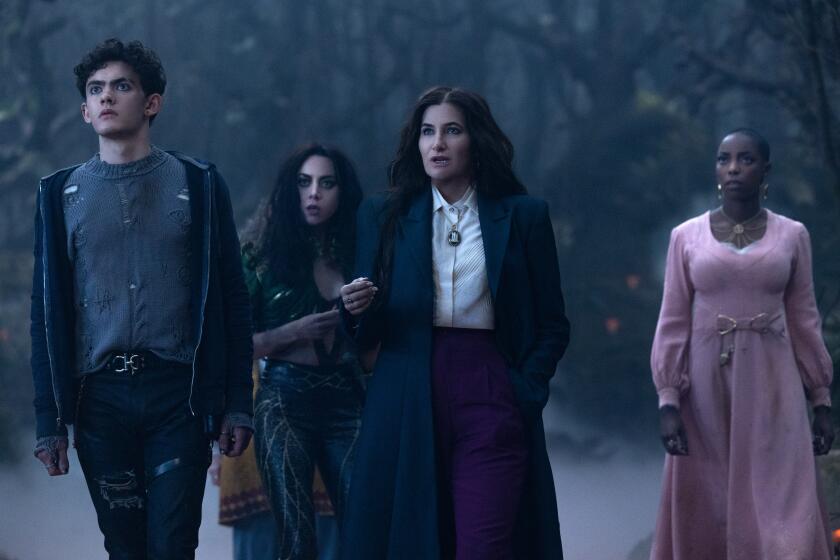From Redwood Forests to Polluted Waters, This Land Is Photographed : Art: Traveling exhibit showcases a new generation of American photographers who study man’s place in nature.
Zipping around on L.A.’s intricate web of freeways, or just driving down an isolated country road, is to experience two worlds: nature’s and our own. In Los Angeles on a clear day, the beauty of the distant, snow-capped San Gabriel Mountains competes for the driver’s eye with rivers of automobiles and stacks of freeway ramps anchored to the city’s vast landscape.
This visual tension, so dramatic in urban areas--but also noticeable in less-traveled settings--is the concern of a new generation of photographers. Not since the last century have the questions of how Americans use the land and how they live on it been so central to artists working with the camera.
During the last four years, the Smithsonian’s National Museum of American Art in Washington has developed a contemporary landscape photography collection of 300 images that explore these questions. A selection of the photos premiere in the museum’s traveling exhibition “Between Home and Heaven: Contemporary Landscape Photography.”
The collection adds a new chapter to the museum’s deep-rooted American landscape tradition that reaches back to the 19th Century. The new work includes both traditional and experimental images and represents the creativity of 50 young photographers from all quarters of the nation.
This generation of photographers is concerned foremost with new ideas sparked by the coexistence of nature and human culture in this century’s waning years. In contrast to the pristine views of the American landscape recorded by earlier photographers, “these new pictures move away from awed response to a wary, respectful look at the land,” says Merry Foresta, the museum’s curator of photography who organized the collection.
Each artist, she says, is influenced by an “understanding of the many ways nature is a sustaining resource, a physical record of human actions and a mystery beyond comprehension.”
The photo collection portrays the consequences of modern land development and issues such as water pollution and soil depletion that threaten the landscape. But the collection records technologies and networks that have united the country and also captures evidence of the earliest interactions between humankind and nature.
The photographs of Terry Toedtemeier, of Portland, Ore., and Linda Connor, of San Anselmo, Calif., for instance, evoke encounters of distant times--petroglyphs on ancient stones or prehistoric hand symbols arranged in a neat row along the fault lines of a geologic formation in Utah. From such photographs, it is clear that the “imprint” of civilization on nature is nothing new.
The theme of the museum’s collection, which was formed with the financial support of the Consolidated Natural Gas Co. Foundation, emerged in the mid-1980s when Foresta realized that “the most passionate photography I was seeing was about the landscape.”
Foresta soon began to acquire pictures by emerging artists who she felt brought a fresh perspective to how Americans interact with the land. None of the works selected, however, depict human figures--this was Foresta’s single self-imposed limit.
The photos represent a variety of themes and concerns, and all avoid picture-postcard stereotypes. Naturalist and Harvard University professor Stephen Jay Gould comments on the timeliness of the collection: “We must move beyond the theme of squalid waste dumps versus beautiful countryside, for it is profoundly unhelpful in casting the two realms of nature and culture intrinsically apart.”
Many of the artists are clearly motivated by a deep nostalgia for the American wilderness; more often eulogy than celebration, their work refers to an earlier pictorial tradition. Whether pictures of the Everglades, the Delaware River or Hawaii’s Haleakala volcano, these images are striking and sumptuous. Yet, Gould notes, the images differ dramatically from those of the past. “Not a single one attempts to show vistas of a large scale. Every single example is a cameo of something small--a little oasis in a world of intricate interaction.”
The degree to which the artists are influenced by tradition varies. Allen Hess of Pittsford, N.Y., for instance, says his romantic photographs have references in 19th-Century photography, from his use of a large turn-of-the-century camera to the subject matter itself. One image shows an approach to Louisiana’s Oak Alley Plantation, where great trees grow in rigidly cultivated formation.
Toedtemeier, however, says he is not trying to “mimic the style of earlier work” but is only “concerned with the rigor of the landscape and the visual evidence of our presence on it.” And Barbra Bosworth of Cambridge, Mass., says that sometimes she takes pictures “simply because I love the way the land looks.” The work of many artists, in fact, discovers often overlooked art and patterns within the landscape.
The pastoral tradition is updated by some artists with an ironic twist. One image by John Yang of New York City pictures a haze-shrouded golf course, a last vestige of open space for many urban residents.
The encounter of nature and contemporary life catches the eye of many of these artists. Peter Goin of Reno, Nev., shows the dramatic march of urban development, abruptly abutting a cleared “no-man’s land” along the Mexican-American border. Richard Misrach of Emeryville, Calif., who takes elegant and paradoxical pictures of test-bomb craters in the Southwest, says that landscape photography “is not an autonomous aesthetic object. It also carries weighty cultural landscape baggage that can no longer be ignored.”
Humor motivates other artists whose pictures probe the lopsided balance between enduring nature and transient civilizations. Jim Stone of Dorchester, Mass., photographed a trailer and truck, overwhelmed by the vastness of Arizona’s desert and mountains beyond, parked beside a great circular drive the owners had marked in the barren landscape.
A harmony of mankind and nature is seen in many photographs: graceful spans of bridges crossing deep canyons and rivers as well as row upon golden row of cultivated wheat ready for harvest.
In the spirit of 19th-Century documentary photographs, some artists now address land management and conservation issues, including the development of agricultural acreage, the use of land for weapon testing or the pollution of natural resources. Many of these images--such as Buffalo, N.Y., photographer John Pfahl’s view of the Three Mile Island nuclear site or San Francisco artist Robert Dawson’s picture of soapsuds floating along a California channel--are visually compelling, drawing viewers into complex issues.
More to Read
The biggest entertainment stories
Get our big stories about Hollywood, film, television, music, arts, culture and more right in your inbox as soon as they publish.
You may occasionally receive promotional content from the Los Angeles Times.










